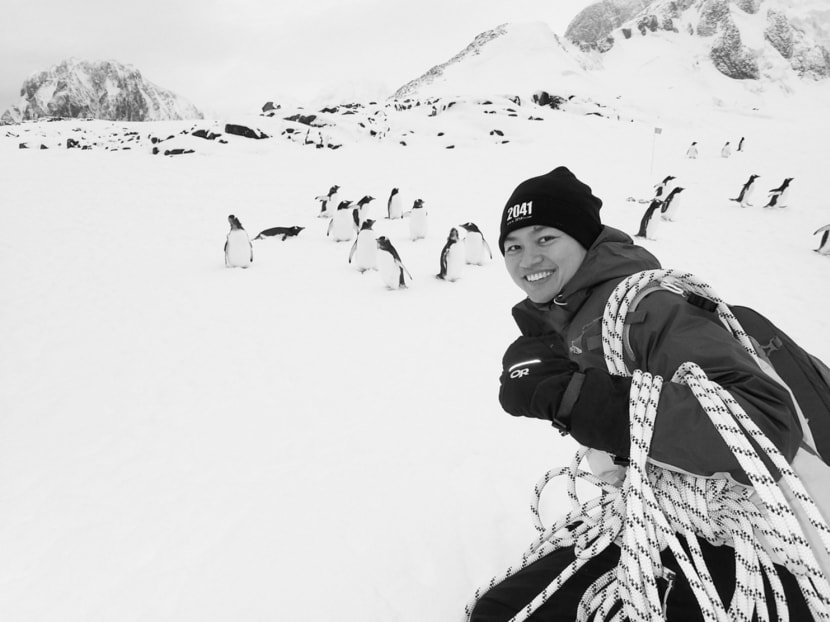Up close with a cold and inconvenient truth
After more than 22,000km of connecting flights and another two days across the infamous Drake Passage — the vast body of water between the southern tip of South America and Antarctica — I was suddenly surrounded by cheers of “land ahoy”.

The International Antarctic Expedition is part of a movement aimed at working towards the continuing protection of the Antarctic so that it will never be exploited. Photo: Tan Chee Wee
After more than 22,000km of connecting flights and another two days across the infamous Drake Passage — the vast body of water between the southern tip of South America and Antarctica — I was suddenly surrounded by cheers of “land ahoy”.
Along with 81 other expedition participants, I was greeted by a tabular iceberg on the sea horizon. Broken off the west Antarctica ice shelves, the iceberg was the size of more than 20 football fields. Its size was so astounding, it took my breath away on the start of my journey to discover the Antarctic — the last pristine place on Earth.
Having heard so much about its beauty and wildlife and inspired by the works of Mr Robert Swan, the first man who walked to North and South Poles, I jumped at the opportunity to join him and participants from 26 countries in the 2041 International Antarctic Expedition (IAE). The name of the expedition is in itself a reminder that in 2041, the Protocol on Environmental Protection to the Antarctic Treaty could potentially be modified or amended. Thus, these expeditions are part of a movement aimed at working towards the continuing protection of the Antarctic Treaty so that this last great wilderness is never exploited.
Witnessing the effects of climate change first-hand was a poignant moment for me. The inconvenient truth was plain to see: The massive iceberg that greeted us was floating unrestricted and melting in the Antarctic sea, and as some media reports have indicated, in the worst case scenario, Antarctica’s melt could push sea levels up 3m worldwide in a century or two, disrupting ecosystems and environments.
A few other defining moments stood out. First was the polar plunge. With my heart pounding and blood pumping with adrenaline, I dived into the icy Antarctic waters. It was painfully fun but I am glad I got that box ticked. The second was gazing from my sleeping bag, at the Milky Way which was spectacularly beautiful. The last and best moment was my conversation with Mr Swan, where we talked about how privileged we were that our work and motivations are aligned to great causes.
As a manager in climate change and sustainability services at EY, I advise clients on corporate sustainability practices and related issues. Yet, the message on the fundamental importance of arresting climate change has never been so clear to me till now.
Reflecting on our urban lifestyles in Singapore, often shielded in air-conditioned offices or homes, a chilling thought that our shoreline may not last beyond another generation hit me hard.
And to bring about true change in our attitudes and behaviour will require individuals, businesses and regulators to all play their part.
RISING CORPORATE INTEREST IN SUSTAINABILITY
Last September, the European Union joined Australia, South Africa, India, Hong Kong, Brazil and others in requiring large companies and groups to disclose non-financial and diversity information on policies, risks and outcomes regarding environmental and social matters.
Investors have joined in the fold as well. Many institutional investors are factoring in environment, social and governance information, particularly their related risks, when making investment decisions.
The Singapore Exchange has begun consultation with listed companies on “comply or explain” sustainability reporting. This growing interest on sustainability reporting has implications for businesses as the concept takes root in boardrooms and the minds of consumers.
Based on a report published by EY in association with Global Reporting Initiative, sustainability reporting could be reaching a “tipping point”. The drivers and benefits of sustainability reporting are increasing in prominence, and standards, regulations and transparency are making sustainability practices more mainstream.
Beyond just regulatory obligations, public concerns and customer expectations over greenhouse gas emissions, waste and water management, and other societal issues are also driving corporate interest in sustainability. Amid resource constraints, whether due to climate change, decreasing supplies, geopolitics, price increases or sustainability concerns, firms are seeking to manage their operations and business more efficiently.
The business case for environmental sustainability is clear. Research by Harvard Business School has shown that high sustainability firms dramatically outperform in terms of stock market performance and accounting measures in the long term.
While the business case for change may not always be altruistic in nature, the fact that investors are increasingly favouring businesses that embrace sustainability practices serves as a wake-up call for many.
As the saying goes: “We do not inherit the earth from our ancestors; we borrow it from our children”. The question we need to constantly ask ourselves is: How far can and will we go to be responsible guardians?
ABOUT THE AUTHOR:
Tan Chee Wee is manager, climate change and sustainability services at EY in Singapore. T he views expressed here are his own.






